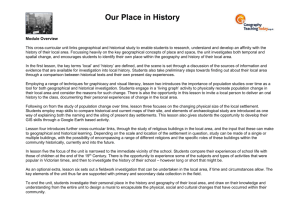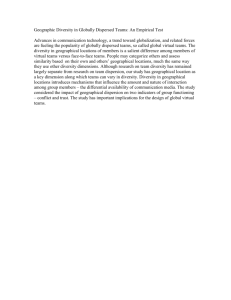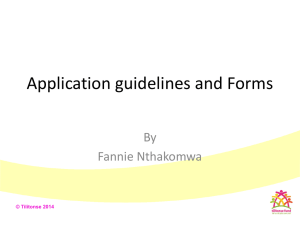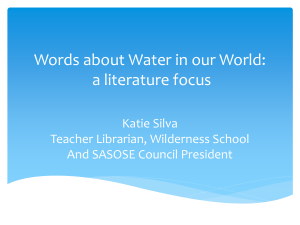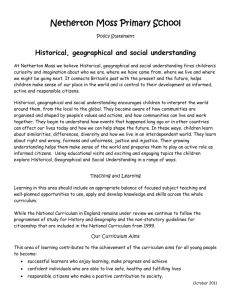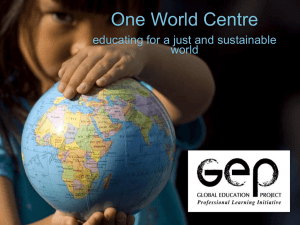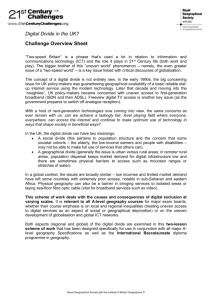Unit Plan and Assessment
advertisement
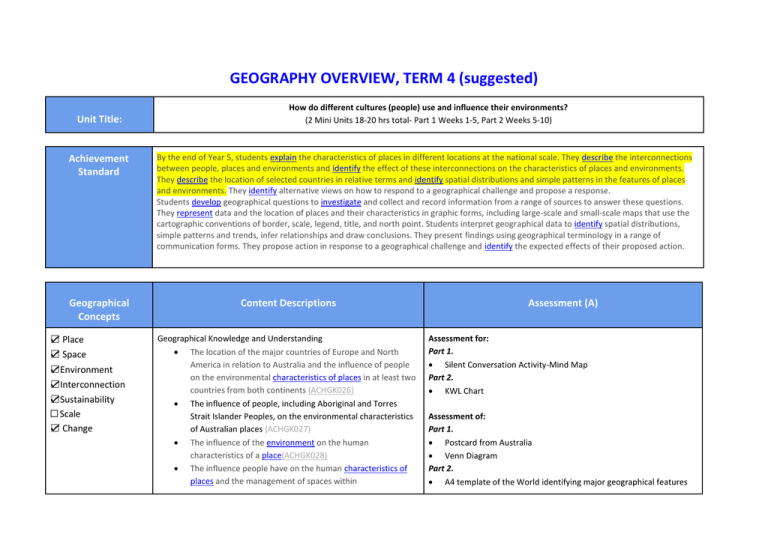
GEOGRAPHY OVERVIEW, TERM 4 (suggested) Unit Title: Achievement Standard Geographical Concepts ☑ Place ☑ Space ☑Environment ☑Interconnection ☑Sustainability ☐ Scale ☑ Change How do different cultures (people) use and influence their environments? (2 Mini Units 18-20 hrs total- Part 1 Weeks 1-5, Part 2 Weeks 5-10) By the end of Year 5, students explain the characteristics of places in different locations at the national scale. They describe the interconnections between people, places and environments and identify the effect of these interconnections on the characteristics of places and environments. They describe the location of selected countries in relative terms and identify spatial distributions and simple patterns in the features of places and environments. They identify alternative views on how to respond to a geographical challenge and propose a response. Students develop geographical questions to investigate and collect and record information from a range of sources to answer these questions. They represent data and the location of places and their characteristics in graphic forms, including large-scale and small-scale maps that use the cartographic conventions of border, scale, legend, title, and north point. Students interpret geographical data to identify spatial distributions, simple patterns and trends, infer relationships and draw conclusions. They present findings using geographical terminology in a range of communication forms. They propose action in response to a geographical challenge and identify the expected effects of their proposed action. Content Descriptions Geographical Knowledge and Understanding The location of the major countries of Europe and North America in relation to Australia and the influence of people on the environmental characteristics of places in at least two countries from both continents (ACHGK026) The influence of people, including Aboriginal and Torres Strait Islander Peoples, on the environmental characteristics of Australian places (ACHGK027) The influence of the environment on the human characteristics of a place(ACHGK028) The influence people have on the human characteristics of places and the management of spaces within Assessment (A) Assessment for: Part 1. Silent Conversation Activity-Mind Map Part 2. KWL Chart Assessment of: Part 1. Postcard from Australia Venn Diagram Part 2. A4 template of the World identifying major geographical features them (ACHGK029) Geographical Inquiry and Skills Observing, questioning and planning 1. Develop geographical questions to investigate and plan an inquiry (ACHGS033) Collecting, recording, evaluating and representing 1. 2. 3. Collect and record relevant geographical data and information, using ethical protocols, from primary and secondary sources, for example, people, maps, plans, photographs, satellite images, statistical sources and reports (ACHGS034) Evaluate sources for their usefulness and represent data in different forms, for example, maps, plans, graphs, tables, sketches and diagrams (ACHGS035) Represent the location and features of places and different types of geographical information by constructing large-scale and small-scale maps that conform to cartographic conventions, including border, source, scale, legend, title and north point, using spatial technologies as appropriate (ACHGS036) Interpreting, analysing and concluding 1. Interpret geographical data and other information, using digital and spatial technologies as appropriate, and identify spatial distributions, patterns and trends, and infer relationships to draw conclusions (ACHGS037) Communicating 1. Present findings and ideas in a range of communication forms, for example, written, oral, graphic, tabular, visual and maps; using geographical terminology and digital European Map template with recorded information of 2 countries. North American Map template with recorded information of 2 countries. Assessment as: Part 1. Letter to the Local Council Planning Department Part 2. Map Tests and Multiple Choice for North America and Europe technologies as appropriate (ACHGS038) Reflecting and responding 1. Learning Framework Cross Curricula Priorities General Capabilities Links to other LA’s Reflect on their learning to propose individual and collective action in response to a contemporary geographical challenge and describe the expected effects of their proposal on different groups of people (ACHGS039) ☑ Community Contributor ☑Leader and Collaborator ☑Active Investigator ☑Effective Communicator ☑Catholic Ethos ☑Aboriginal and Torres Strait Islander Histories and Cultures ☑Social Emotional Learning ☐Asia and Australia’s Engagement with Asia ☑ Inclusive Education ☑Sustainability Education ☑Literacy ☑Critical and Creative Thinking ☑Numeracy ☑Ethical Behaviour ☑Information and Communication Technology ☑Personal and Social Competence English, Numeracy, ICT, History ☑Designer and Creator ☑ Quality Producer Learning and Teaching Strategies Week 1 Cross Curricula Priorities General Capabilities Engage ⇒ 2 3 4 5 6 7 8 10 ☑Catholic Ethos ☑Aboriginal and Torres Strait Islander Histories and Cultures ☑Social Emotional Learning ☐Asia and Australia’s Engagement with Asia ☑ Inclusive Education ☑Sustainability Education ☑Literacy ☑Critical and Creative Thinking ☑Numeracy ☑Ethical Behaviour ☑Information and Communication Technology ☑Personal and Social Competence Explore ⇒ Explain ⇒ Elaborate ⇒ ENGAGE PART 1. Lesson 1. (1 hr) A)Share a text (see suggested in Resources column); discuss themes of population and settlement and the impacts on the environment. B)Conduct a Silent Conversations Activity; Use questions like What’s changed? How have humans changed this environment? What’s stayed the same? What features of the natural environment have humans utilised? How? What features of the natural environment have impeded urban development? How? C) Share findings and create a class Mind Map of responses (eg. Ipad Apps; poplet, tools4teachers, total recall etc) Lesson 2.(1hr) Options- 9 Evaluate Resources Suggested Texts ‘Window’ by Jeannie Baker ‘Where the Forest Meets the Sea’ by Jeannie Baker ‘Mirror’ by Jeannie Baker ‘Belonging’ by Jeannie Baker ‘My Place’ by Nadia Wheatley and Donna Rawlins A5 paper with Silent A)We Do Activity; Invite a guest speaker (local ABTSI Elder) to come and talk re indigenous people’s use and management of the land B) We Do Activity; Excursion to a local indigenous cultural centre (eg. Tjapukai, Mossman Gorge Cultural Centre, Walker Bros. Tours-Mossman, Mamu-Innisfail/Southern Tablelands district) Geographical Language Geography, influence, people, environmental, places, characteristics, human, place, spaces, management, collect, climatic conditions, landforms, settlements, food production, natural, organised, zoning, local planning, farming Reflection conversations questions -IWB or Ipad for Mind mapping Activity http://www.mamu.org.au/ http://www.nprsr.qld.gov. au/parks/mamu/environe mental-education.html -Book; ‘Yalanji’ by Warranga Kaban Assessment Opportunities ForSilent Conversation Activity-Mind Map Week 1 Cross Curricula Priorities General Capabilities Engage ⇒ 2 3 4 5 6 7 8 9 10 ☑Catholic Ethos ☑Aboriginal and Torres Strait Islander Histories and Cultures ☑Social Emotional Learning ☐Asia and Australia’s Engagement with Asia ☑ Inclusive Education ☑Sustainability Education ☑Literacy ☑Critical and Creative Thinking ☑Numeracy ☑Ethical Behaviour ☑Information and Communication Technology ☑Personal and Social Competence Explore ⇒ Explain ⇒ Elaborate ⇒ EXPLORE Lesson 1.(1hr) A) I Do/We Do Activity; Teacher models using the Power Point, Where Australians Live’, explore Power Point Presentation using and discussing pictures, maps (eg keys, colour, symbols etc) and use questioning to prompt discussion from the ‘content and information in the slides. Lesson 2.(1hr) A)You Do Activity; Using activity from Power Point (slide No. 22), students create a Postcard from Australia Evaluate Resources http://www.slideshare.net /celestetfrey102685/austr alia-where-australians-live3493755 Geographical Language Geography, Australia, influence, people, environmental, places, characteristics, human, place, spaces, management, collect, geographical, data, information, location, maps, border, sources, legend, title, compass points, major, industries, sustainability, interpret, features, globe, climatic conditions, landforms, settlements, food production, natural, organised, zoning, local planning, farming Reflection Assessment Opportunities OfPostcard from Australia Week 1 Cross Curricula Priorities General Capabilities Engage ⇒ 2 3 4 5 6 7 8 9 10 ☑Catholic Ethos ☑Aboriginal and Torres Strait Islander Histories and Cultures ☑Social Emotional Learning ☐Asia and Australia’s Engagement with Asia ☑ Inclusive Education ☑Sustainability Education ☑Literacy ☑Critical and Creative Thinking ☑Numeracy ☑Ethical Behaviour ☑Information and Communication Technology ☑Personal and Social Competence Explore ⇒ Explain ⇒ Elaborate ⇒ Evaluate EXPLAIN Resources Lesson 1. (1hr) A)We Do Activity; Pose questions for class discussion What development/redevelopment is happening in our local area? How does this affect us? How do councils organise the use of space through zoning? (Economic, Environmental, population growth etc) B)Use local council Zoning maps to identify how we use space (or future use) in our local area. OR C)Visit Local Council Planning Dept. and have a representative talk to students re use of and proposed use of local area/space. OR D)Invite Local Council Planning Dept. Representative to be a guest speaker to talk to students re use of and proposed use of local area/space. Lesson 2. (1hr) A)You Do Activity; Pairs create a Venn Diagram of the Positive and Negative Effects of this local development. IWB; to record answers of discussion questions Local Council websites for access to local zoning maps Venn Diagram template or Apps (eg Tools4Teachers) Geographical Language Geography, Australia, influence, people, environmental, places, characteristics, human, place, spaces, management, collect, geographical, data, information, location, maps, border, sources, legend, title, compass points, major, industries, sustainability, interpret, features, globe, climatic conditions, landforms, settlements, food production, natural, organised, zoning, local planning, farming Reflection Assessment Opportunities OfVenn Diagram Week 1 Cross Curricula Priorities General Capabilities Engage ⇒ 2 3 4 5 6 7 8 9 10 ☑Catholic Ethos ☑Aboriginal and Torres Strait Islander Histories and Cultures ☑Social Emotional Learning ☑Asia and Australia’s Engagement with Asia ☑ Inclusive Education ☑Sustainability Education ☑Literacy ☑Critical and Creative Thinking ☐Numeracy ☑Ethical Behaviour ☑Information and Communication Technology ☑Personal and Social Competence Explore ⇒ Explain ⇒ Elaborate ⇒ ELABORATE Lesson 1/2 (2hrs) A)You Do Activity; After comparing the Positive/Negative Effects of the development in your local area and developing your own ideas regarding the issue, write a Letter back to the Local Council Planning Dept. Representative to express your point of view! -Draft letter -Edit -Publish Evaluate Resources Geography Journals for drafting of Letter. Choice for published lettercomputer typed/handwritten. Geographical Language Geography, continents, North America, Europe, Australia, influence, people, environmental, places, characteristics, human, place, spaces, management, collect, geographical, data, information, location, maps, border, sources, legend, title, compass points, major, industries, sustainability, interpret, features, globe, climatic conditions, landforms, settlements, food production, natural, organised, zoning, local planning, farming Reflection Assessment Opportunities AsLetter to Local Council Planning Department Week 1 Cross Curricula Priorities General Capabilities Engage ⇒ 2 3 4 5 6 7 8 9 10 ☑Catholic Ethos ☐Aboriginal and Torres Strait Islander Histories and Cultures ☑Social Emotional Learning ☐Asia and Australia’s Engagement with Asia ☑ Inclusive Education ☐Sustainability Education ☑Literacy ☑Critical and Creative Thinking ☐Numeracy ☑Ethical Behaviour ☑Information and Communication Technology ☑Personal and Social Competence Explore ⇒ Explain ⇒ Elaborate ⇒ Evaluate EVALUATE PART 2Lesson 1 (1hr) A)Engage the students by using one of the following suggested websites/ipad apps where the students play a game that allows them to ‘find’ certain countries, continents etc. Start with a World Map, then focus in on Australia, Europe and North America. Discuss with the students – What’s something new you discovered? What surprised you? What do you want to know? Record on a class K/W/L chart Lesson 2: (1hr) A)Pose Inquiry Question What is a Continent? Devise a Class Definition for ‘Continent’; identify major continents of the world! Students use either computers, ipads or atlases to access world maps and then identify and mark on the major geographical features (eg. Polar Regions, Tropics, Equator and Major Continents) using either colour/shading/keys on a blank Paper template. Resources Apps: Tap-quiz maps, Geoquiz Websites: Ilike2learn.com Access to either computers, ipads or class set of Atlases. A4 template of the World Geographical Language Geography, continents, North America, Europe, Australia, place, spaces, collect, geographical, data, information, location, maps, border, sources, legend, title, compass points, globe, Assessment Opportunities For KWL Chart Of A4 template of the World identifying Major Geographical features. Week 1 Cross Curricula Priorities General Capabilities Engage ⇒ 2 3 4 5 6 7 8 9 10 ☑Catholic Ethos ☐Aboriginal and Torres Strait Islander Histories and Cultures ☑Social Emotional Learning ☐Asia and Australia’s Engagement with Asia ☑ Inclusive Education ☐Sustainability Education ☑Literacy ☑Critical and Creative Thinking ☐Numeracy ☑Ethical Behaviour ☑Information and Communication Technology ☑Personal and Social Competence Explore ⇒ Explain ⇒ Elaborate ⇒ Evaluate EVALUATE PART 2Lesson 1 (1hr) A)We Do Activity; Pose Question, ‘Where is Europe?’ (ie a Continent in the Northern Hemisphere, consisting of 45countries) Teacher use Google Maps/National Geographic World Atlas to locate and zoom in on a Map of Europe; identify the names of the countries and capital cities. Students make a list of these countries/capitals in their Geography Journals. B)I Do Activity; Teacher to choose one country (eg. Sweden); Identify the position and layout of Landforms, river systems/waterways, sea/gulf access and discuss in relation to population settlement. Ie Where is the capital? What is the total population? Where is most of the population situated? What natural features may have influenced where people settled? Using websites or ipad app (see Resources), identify main topic areas (eg Landforms, Capital, Population, Climate, Farming/Food Production, Industry, other city locations) and how to locate this information using internet search. Teacher modelled how to access, collect and record this information onto a blank map template of Europe (use key-colours, shading, symbols etc. for each). Resources Computer/data Projector/IWB/Ipad with Google Earth/National Geographic World Atlas Geography Journals https://www.cia.gov/li brary/publications/the -world-factbook Ipad app; World factbook. Lesson 2: (1hr) A)You Do Activity; Students choose another European Country and use Atlases, ipads, computers to locate, access, collect and record information as per teacher modelling in previous lesson. They record their information onto previous map template (thereby having information for 2 European Countries on the one map!) Geographical Language Geography, continents, North America, Europe, Australia, place, spaces, collect, geographical, data, information, location, maps, border, sources, legend, title, compass points, globe, Access to computers, ipads, atlases Assessment Opportunities Of European Map template with recorded information of 2 countries Week 1 Cross Curricula Priorities General Capabilities Engage ⇒ 2 3 4 5 6 7 8 9 10 ☑Catholic Ethos ☐Aboriginal and Torres Strait Islander Histories and Cultures ☑Social Emotional Learning ☐Asia and Australia’s Engagement with Asia ☑ Inclusive Education ☐Sustainability Education ☑Literacy ☑Critical and Creative Thinking ☐Numeracy ☑Ethical Behaviour ☑Information and Communication Technology ☑Personal and Social Competence Explore ⇒ Explain ⇒ Elaborate ⇒ Evaluate EVALUATE PART 2Lesson 1 (1hr) A)We Do Activity; Pose Question, ‘Where is North America?’ (ie a Continent in the Northern Hemisphere, consisting of 23 countries) Teacher use Google Maps/National Geographic World Atlas to locate and zoom in on a Map of North America; identify the names of the countries (note- this includes Central American Countries and the Caribbean!) and capital cities. Students make a list of these countries/capitals in their Geography Journals. B)I Do Activity; Teacher to choose one country (eg. Panama); Identify the position and layout of Landforms, river systems/waterways, sea/gulf access and discuss in relation to population settlement. Ie Where is the capital? What is the total population? Where is most of the population situated? What natural features may have influenced where people settled? Using websites or ipad app (see Resources), identify main topic areas (eg Landforms, Capital, Population, Climate, Farming/Food Production, Industry, other city locations) and how to locate this information using internet search. Teacher modelled how to access, collect and record this information onto a blank map template of Europe (use key-colours, shading, symbols etc. for each). Resources Computer/data Projector/IWB/Ipad with Google Earth/National Geographic World Atlas Geography Journals https://www.cia.gov/li brary/publications/the -world-factbook Ipad app; World factbook. Lesson 2: (1hr) A)You Do Activity; Students choose another North American Country and use Atlases, ipads, computers to locate, access, collect and record information as per teacher modelling in previous lesson. They record their information onto previous map template (thereby having information for 2 European Countries on the one map!) Geographical Language Geography, continents, North America, Europe, Australia, place, spaces, collect, geographical, data, information, location, maps, border, sources, legend, title, compass points, globe, Access to computers, ipads, atlases Assessment Opportunities Of North American Map template with recorded information of 2 countries Week 1 Cross Curricula Priorities General Capabilities Engage ⇒ 2 3 4 5 6 7 8 9 10 ☑Catholic Ethos ☐Aboriginal and Torres Strait Islander Histories and Cultures ☑Social Emotional Learning ☐Asia and Australia’s Engagement with Asia ☑ Inclusive Education ☐Sustainability Education ☑Literacy ☑Critical and Creative Thinking ☐Numeracy ☑Ethical Behaviour ☑Information and Communication Technology ☑Personal and Social Competence Explore ⇒ Explain ⇒ Elaborate ⇒ Evaluate EVALUATE PART 2Completion of any unfinished collection and recording of information from previous 2 weeks! Resources Early Finishers; Repeat Previous investigation using ‘Australia” Computer/data Projector/IWB/Ipad with Google Earth/National Geographic World Atlas Geography Journals https://www.cia.gov/li brary/publications/the -world-factbook Ipad app; World factbook. Access to computers, ipads, atlases Geographical Language Assessment Opportunities Geography, continents, North America, Europe, Australia, place, spaces, collect, geographical, data, information, location, maps, border, sources, legend, title, compass points, globe, Week 1 2 3 4 5 6 7 8 Of North American Map template with recorded information of 2 countries 9 10 Cross Curricula Priorities General Capabilities Engage ⇒ ☑Catholic Ethos ☑Aboriginal and Torres Strait Islander Histories and Cultures ☑Social Emotional Learning ☑Asia and Australia’s Engagement with Asia ☑ Inclusive Education ☑Sustainability Education ☑Literacy ☑Critical and Creative Thinking ☐Numeracy ☑Ethical Behaviour ☑Information and Communication Technology ☑Personal and Social Competence Explore ⇒ Explain ⇒ Elaborate ⇒ EVALUATE Resources Lesson 1 (1hr) A)You Do Activity; Final Assessment using Map Test and Multiple Choice Lesson 2 (1hr) A)You Do Activity; Final Assessment using Map Test and Multiple Choice Geographical Language Geography, continents, North America, Europe, Australia, influence, people, environmental, places, characteristics, human, place, spaces, management, collect, geographical, data, information, location, maps, border, sources, legend, title, compass points, major, industries, sustainability, interpret, features, globe, climatic conditions, landforms, settlements, food production, natural, organised, zoning, local planning, farming Reflection Evaluate Exploring Geography North America- RIC Publications Ages 8-12 (p. 110) Exploring Geography Europe- RIC Publications Ages 8-12 (p. 110) Assessment Opportunities OfMap Tests and Multiple Choice Week 1 2 3 4 5 6 7 8 9 10 Cross Curricular Priorities General Capabilities Engage ⇒ Explore ⇒ Explain ⇒ Elaborate ⇒ EVALUATE Evaluate Resources Lesson 1: (1hr) Lesson 2: (1hr) Geographical Language Geography, continents, North America, Europe, Australia, influence, people, environmental, places, characteristics, human, place, spaces, management, collect, geographical, data, information, location, maps, border, sources, legend, title, compass points, major, industries, sustainability, interpret, features, globe, climatic conditions, landforms, settlements, food production, natural, organised, zoning, local planning, farming Reflection Assessment Opportunities Planning for Differently Abled Students Student/s Different Ability Australian Curriculum Content Descriptions being addressed Learning and Teaching Strategies Assessment Strategies
